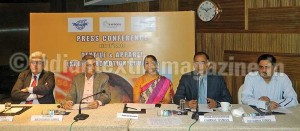
Texprocil has made a number of recommendations to ensure growth in India’s exports so as to achieve the textile export target of $13.5 billion.
The Cotton Corporation of India (CCI) which is a well-staffed cotton procurement and sales organization must be mandated to use its reach and procure cotton during periods when the local cotton is cheaper than international prices and offload it for mills at regular intervals whenever there is a threat of cotton prices breaching the international prices. This will benefit farmers, as they will get higher prices during the harvest period. It will also benefit mills as they will not be impacted by the operations of large traders who use their holding capacity and ability to sell futures in the NY market to cause Indian prices to go over the international rates for six months each year.
CCI will be able to use its 600-strong human resource at all times and prove its worth by making commercial operations and profits. It has to broadbase its Board to include stake-holders to give commercial wisdom. As of today, one Joint Secretary and three Government-paid executives alone are directors of such a huge commercial organization.
Further, in order to overcome the external barriers and restore a semblance of level playing field, the Foreign Trade Policy (FTP) should address the major issues appropriately. FTP has four broad objectives – to maximize India’s forex earnings for a given incentive outflow, create the maximum number of jobs for a given incentive outflow, incentivize exports of products / commodities that have head room to grow, and to offset the extra freight costs incurred while exporting to distant markets.
On all four points, cotton textile exports, be it yarns, fabrics or ‘cut and sew’, deserve higher incentives than engineering exports, electronic assembled products like set-up boxes, furniture, bicycles, two-wheelers, etc., as textiles has near zero import content as against 25-90 per cent import content in the above listed products.
Textiles create 10 to 20 times more jobs than the listed products and that too in tier 3/4 locations for unskilled persons of both sexes.
Textiles have lower FOB value and therefore suffer higher logistic costs in percentage terms and therefore deserve a higher percentage as focus market incentives to offset the extra freight cost as compared to the listed products.
However, in reality, FTP is not implemented as per the stated objectives, and textiles receive the lowest instead of highest incentives. Texprocil wants the Government to strictly follow the policy announced. Doing so with a logic of giving higher incentives where there is a lack of level playing field will go a long way in increasing India’s exports per rupee given out as incentive.
Also proposed are the incentives for yarns, fabrics and ‘cut and sew’ (all to be notified at the 2/4 digit code level to prevent unintended exclusions) for different country groups based on a clearly articulated logic.
Logic-based incentives as opposed to lobbying-based, but strictly in accordance with the stated objectives, will substantially increase India’s exports and net foreign exchange earned, besides creating lakhs of additional jobs without increasing the overall outflow of incentives.
Export data for fiscal 2013-2014 were cotton yarn $4.5 billion, cotton fabric $2.13 billion and cotton home textiles $4.79 billion.
The Indian yarn and made-up exports were impacted by different factors. First, Indian cotton prices remained higher than international rates since February. It is extremely difficult even for the highly efficient spinning sector to export its products. Second, home textile exports got impacted as India’s main competitor Pakistan, gained zero duty access in the EU market, against 9.6 per cent customs duty for products from India. Third, fabric exports have registered a small increase due to improved penetration into markets where India enjoys duty-free access.